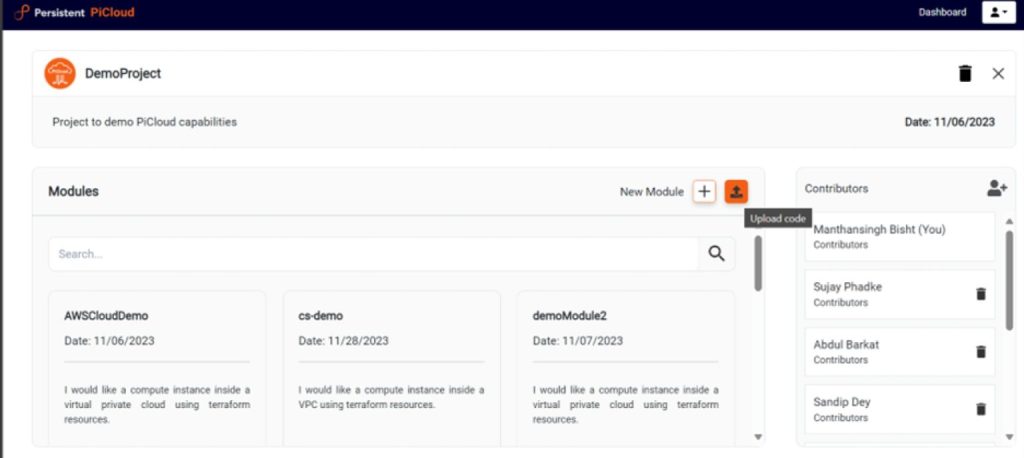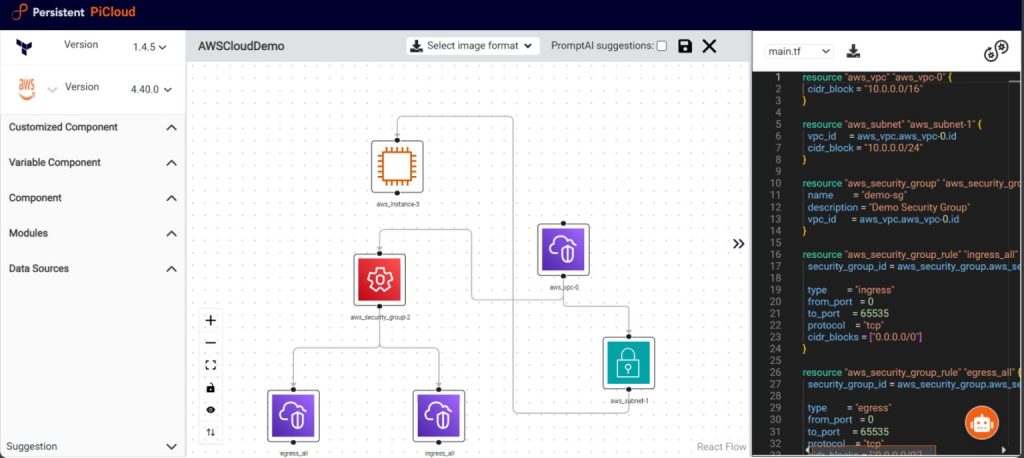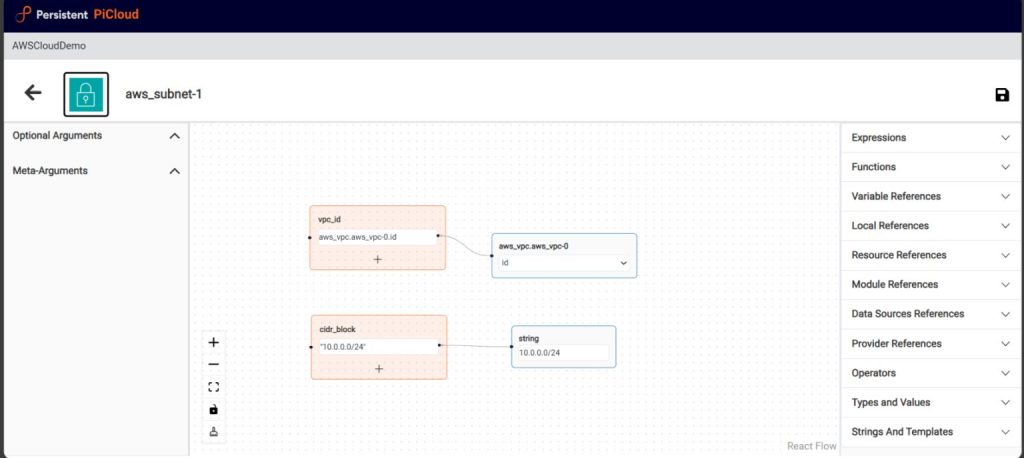In our previous blog, we highlighted the need for a visual Low Code No Code (LCNC) solution for rapidly building cloud infrastructure. Consequently, we introduced PiCloud – Persistent’s own Generative AI-based visual LCNC solution for interactively building a cloud infrastructure, all visually. PiCloud builds upon and leverages PiCAS (Persistent Cloud Automation Stack) toolkit to generate high-quality infrastructure as code using battle-hardened, reusable and composable terraform artifacts that have built-in security, compliance, governance and observability features.
With the latest version of PiCloud, we are moving towards the vision of an integrated solution that not only has cloud development capabilities but also offers cloud deployment considerations.
PiCloud and its Advantages
PiCloud is a completely visual LCNC offering that leverages Generative AI (GenAI) capabilities to enable users to rapidly build their cloud infrastructure without manually writing a single line of infrastructure code. The tool does it all for the users!
The latest version of PiCloud has an exciting set of features that offer users cloud development capabilities, support with DevSecOps and more specifically pre-deployment considerations.
- While PiCloud’s Generative AI capabilities can pre-render a first cut of cloud architecture with code, an intuitive and multi-layer visual interface and AI chatbot Megh (meaning cloud in Sanskrit and many other Indian languages) enable users to interactively develop their architecture further. In this process, users do not write a single line of infrastructure code. They just focus on architecting while the code gets built for them.
- PiCloud offers Click, Drag and Drop based powerful visual editing that can help one build complex programming constructs (dynamic behavior, controls, loops, nesting, etc.) in their code with ease.
- PiCloud also allows users to import their existing infrastructure as code (developed elsewhere) into the PiCloud tool. This way, users can leverage PiCloud to do further additional development on their existing code. Since PiCloud is targeted towards users with little or no terraform knowledge, this feature can help organizations build their infrastructure further with resources not skilled in IaC.
- PiCloud offers a collaborative development capability where members of a project can work together to build the modules for their cloud infrastructure. The above features enable users to be more productive and help organizations achieve faster time to market.
- PiCloud is not just limited to editing through a visual interface. As mentioned above, users can specify their requirements to Megh while editing cloud resources and it will provide code suggestions and recommendations that users can directly use in their already generated code.
- DevSecOps functionalities like static analysis (SAST) on generated code, cost estimation, pre-deployment compliance and other policy checks and push to repository are introduced to help with infrastructure pre-deployment considerations. The pre-deployment compliance check functionality makes the task of hardening your infrastructure much faster and cheaper than current methodology.
In the following sections, we expand upon some of these important features.
Collaborative project development and importing existing Infrastructure as Code (IaC)
PiCloud introduces the concepts of project and contributors where team members can develop new cloud infrastructure modules collaboratively. Contributors also have the option to upload already built (developed elsewhere) infrastructure modules to a PiCloud project they are working on. These features enable teams to work faster and more productively, helping organizations reduce project development time and costs.

Intuitive multi-layer interface for rapid visual development
Building and editing cloud infrastructure is completely visual as users Click, Drag, Drop and fill out fields while code gets built for them. This no-code methodology enables users with low or no prior terraform experience to effectively use PiCloud.


AI-assisted editing
Megh, the AI Chatbot for PiCloud captures the already built architecture (and code) as a context and generates code suggestions based on user prompts.


Pre-deployment DevSecOps pipelines
Users can run various pre-deployment jobs like static analysis, cost estimation, pre-deployment policy checks and push to the repository on their generated code. PiCloud offers a set of built-in policy files for performing compliance checks and users can also upload their own policy files for doing various policy checks.

At Persistent, we utilize the latest technologies like Generative AI and intuitive LCNC interfaces to help you get faster to market with lower project costs, resourcing burden and a high quality cloud infrastructure.
The upcoming versions of PiCloud will introduce further visual improvements, possibly generating code in other declarative languages, improving capabilities around importing existing IaC, connecting to existing cloud accounts and absorbing already built architectures and resources into PiCloud, one-click resource deployments to cloud, etc.
For more information on PiCloud and to understand how this platform can help you in accelerate your Cloud Migration journey, please reach out to us.
Author’s Profile
Sandip Dey
Principal Architect, Cloud R&D, Corporate CTO Organization







